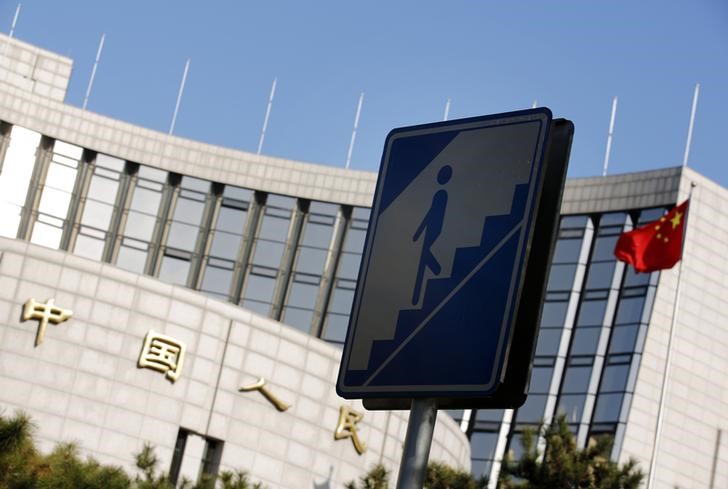By Kevin Yao and Nicholas Heath
BEIJING (Reuters) - China's central bank cut lending rates for the fourth time since November and trimmed the amount of cash that some banks must hold as reserves, stepping up efforts to support an economy that is headed for its poorest performance in a quarter century.
Saturday's combined easing highlights Beijing's concerns that money isn't flowing to some of the most-needed sectors in the economy and that stubbornly high borrowing costs that could fuel bankruptcies and job losses. The last time the central bank simultaneously cut interest rates and reserve requirements was at the height of the global financial crisis in late 2008.
The latest move could also be aimed at comforting investors following a 20 percent plunge in the country's stock markets over the last two weeks, some analysts said.
"The simultaneous cuts in interest rates and reserve requirement is a forceful move, indicating the downward pressure on the economy is very big," said Xu Hongcai, senior economist at the China Centre for International Economic Exchanges (CCIEE), a Beijing-based think-tank.
"The monetary policy adjustment will also help curb sharp fluctuations in the stock market."
Some government economists have been calling for interest rate cuts to help lower real borrowing costs and help local governments to swap their maturing debt, although some private sector analysts have recently pared their expectations on policy easing.
Despite the drumroll of rate cuts, the real cost of borrowing in China remains stubbornly high, due in part to cooling inflation and banks' reluctance to pass lower rates on to their customers. That has further squeezed manufacturers struggling with tepid demand.
The People's Bank of China (PBOC) said on its website that it was lowering the one-year benchmark bank lending rate by 25 basis points to 4.85 percent, and reducing the one-year benchmark deposit rate by 25 basis points to 2 percent.
The central bank also lowered the reserve requirement ratio (RRR) for banks that have met certain standards in lending to the farm sector and small and medium-sized enterprises by 50 basis points.
It lowered reserve requirement for finance companies by 300 basis points, which it said will help ease funding and costs pressure on state-owned enterprises. The move highlights rising concern over the SOE sector where bad debt is concentrated and profit margins are being squeezed.
The central bank has frequently made such targeted cuts in RRR to spur lending into certain sectors, but the impact has been limited since banks are often reluctant to lend to these sectors amid concerns over collateral and risk.
GROWTH SLOWDOWN
The interest rate and RRR cuts will "help stabilise growth, adjust structures and lower social financing costs", the central bank said.
Going forward, the central bank will "continue to implement prudent monetary policy, use various policy tools to strengthen and improve marco-prudential management, optimise policy combinations and create neutral and appropriate monetary and financial environments for economic adjustments and upgrading."
The government is due to release second-quarter GDP data on July 15 and many economists expect growth to dip below 7 percent, which would be the weakest performance since the depths of the global financial crisis.
Weighed down by a property downturn, factory overcapacity and local debt, growth in China's economy is expected to slow to a quarter-century low of around 7 percent this year. That is down from 7.4 percent in 2014, even with expected additional stimulus measures.
China last cut interest rates on May 10. It last cut the reserve requirement ratio for all commercial banks by 100 basis points on April 19 - the deepest single reduction since the depth of the global financial crisis in 2008 - following a 50-basis-point cut in February.
The central bank has cut benchmark lending rate by a total of 115 basis points since November, on top of a total of 150 basis cut in system-wide reserve requirements.
Analysts said Saturday's cut in the RRR to only selected highlights authorities' concern that the easing so far has mainly fuelled speculation in the stock market, and the impact on the overall economy remains limited.

"Speculation in the stock market is decreasing which has helped remove obstacles for policy loosening. The slide in stocks also forced the acceleration of policy loosening," said Guan Qingyou, senior economist at Ginseng Securities.